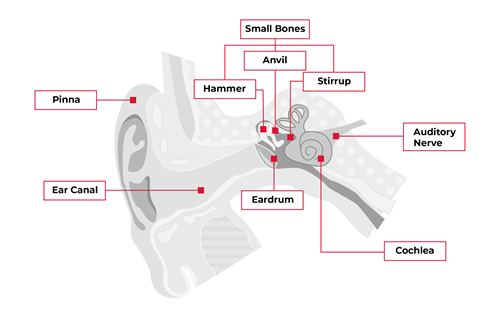Although ear conditions, such as Tinnitus, are becoming more and more widely known, Hyperacusis remains a lesser-acknowledged condition. As part of our series of blogs concerning conditions related to Noise-Induced Hearing Loss, we’re exploring the inner workings of the ear, the symptoms of Hyperacusis and how to live comfortably with the condition.
How do we hear?
To understand Hyperacusis and how noise injury can cause the condition to develop, it’s important to explore how we hear.
Sound waves are vibrations in the air around us that are collected by the pinna and funnelled into the ear canals. These sound waves cause the eardrum to vibrate and move the chain of tiny bones in the middle ear - this then transfers the vibrations into the cochlea of the inner ear. The bones vibrate, creating the fluids in the cochlea to move and stimulate the tiny hair cells. These tiny hair cells determine the pitch of the sound, generating impulses that travel instantly along the auditory nerve and following a pathway in the brainstem before arriving at the hearing centres of the brain.

Everyone has a limit to the loudness level they can comfortably tolerate, however, this limit is not fixed, meaning a person’s mood can also affect their limit. For example, some individuals may find that the sound they can tolerate is lower when they are tired, ill or stressed.
Whatever a person’s noise tolerance, anything above 85 decibels is harmful to the auditory system - and regular, prolonged exposure to sounds of this measure could result in Noise-Induced Hearing Loss, Tinnitus and Hyperacusis.
What is Hyperacusis and how is it caused?
When in a noisy environment, the brain sends information to the inner ear so it can protect itself - essentially, it turns the volume down within the ear. Damage caused to the delicate structures within the ear caused by loud noise exposure disrupts this process and results in hypersensitivity.
Hyperacusis is a condition that affects how an individual perceives sound - it is a hypersensitivity of hearing. This means sufferers have excessively sensitive hearing and find it difficult to tolerate everyday sounds that most people would find quiet or unintrusive - these noises could be from a washing machine, door closing or the hum from a fridge. Those living with the condition feel irritated by sound and may experience pain when exposed to even the most quiet noises.
How to live comfortably with Hyperacusis
By nature, Hyperacusis can be a debilitating, isolating condition, as sufferers often also develop phonophobia (fear of sound) - stopping the individual from attending social events or spending time with family. These conditions commonly go hand-in-hand and only become worse as an individual tries to protect their ears from noise. This is actually counterintuitive as overprotection reduces the ear’s exposure to everyday sounds, causing the ears to become even more sensitive and creating a vicious cycle of overprotection-hyperacusis-phonophobia (OHP). The best way to overcome Hyperacusis and live a happy life is to slowly reintroduce low levels of sound and increase a person’s tolerance. This can be done with a treatment called Sound Therapy.
What is Sound Therapy?
Sound Therapy (the process of desensitisation) is a popular treatment for Hyperacusis. This treatment helps sufferers to desensitise their hearing over a period of several months and involves specialist noise generators to help gradually increase the level of noise that the patient feels comfortable with - ultimately restoring a normalised perception of loudness and reducing the pain response to everyday sounds.
Noise-Induced Hearing Loss Medical Reports at MLA
Here at MLA, we’ve been in the personal injury industry for nearly 30 years, earning a justifiable reputation for producing leading Industrial Disease Medical Reports. Having delivered over 40,000 NIHL Medical Reports, we’re proud to provide a comprehensive range of NIHL screenings, covering Audiology Screening, ENT Reports and CERA Testing.
To learn more about our NIHL services, please click here.


